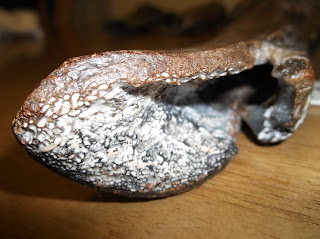 1 - I found this worked stone about 3 years ago in Stainton beck, I am certain it was washed from the gravel beds, I believe it was some sort of shaft smoother.
1 - I found this worked stone about 3 years ago in Stainton beck, I am certain it was washed from the gravel beds, I believe it was some sort of shaft smoother.  8 - If ime honest I can not remember the beck location I found this piece, at first I paid it little attention, thinking it just to be a worn Equus Metatarsal but I now know it to either have been a tool of some sort or a religious or symbolic artifact. The lighter coloured material is actually preserved wood, that has been inserted into the bone.
8 - If ime honest I can not remember the beck location I found this piece, at first I paid it little attention, thinking it just to be a worn Equus Metatarsal but I now know it to either have been a tool of some sort or a religious or symbolic artifact. The lighter coloured material is actually preserved wood, that has been inserted into the bone. 11- 14 This piece I found very close to the stone tool in the first images, I found these pieces a long time ago before I had started any excavating, but have never been in any doubt that they were tools of some sort.
11- 14 This piece I found very close to the stone tool in the first images, I found these pieces a long time ago before I had started any excavating, but have never been in any doubt that they were tools of some sort. 14
14 15 - 19 Digging tools
15 - 19 Digging tools 16
16 17
17 18
18 19
19 20 - 22 Carved bone .
20 - 22 Carved bone . 21
21 22
22 23 - Carved Artefact
23 - Carved Artefact HISTORY OF A BECK: The Stainton gravel beds
HISTORY OF A BECK: Storregga slides Stunami theory































































 .
.